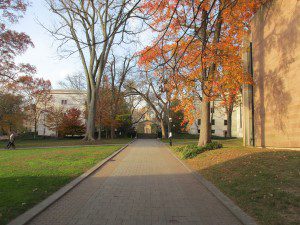 New York Times columnist David Brooks recently wrote a noteworthy article, entitled “The Harlem Miracle”, about an inner-city organization that has wrought considerable change in the lives of its students.
New York Times columnist David Brooks recently wrote a noteworthy article, entitled “The Harlem Miracle”, about an inner-city organization that has wrought considerable change in the lives of its students.
The Harlem Children’s Zone, run by Geoffrey Canada (a Bowdoin alum, like myself), is doing crazy things:
“The typical student entered the charter middle school, Promise Academy, in sixth grade and scored in the 39th percentile among New York City students in math. By the eighth grade, the typical student in the school was in the 74th percentile. The typical student entered the school scoring in the 39th percentile in English Language Arts (verbal ability). By eighth grade, the typical student was in the 53rd percentile.”
Here’s another quantification of this work:
“Forgive some academic jargon, but the most common education reform ideas — reducing class size, raising teacher pay, enrolling kids in Head Start — produce gains of about 0.1 or 0.2 or 0.3 standard deviations. If you study policy, those are the sorts of improvements you live with every day. Promise Academy produced gains of 1.3 and 1.4 standard deviations. That’s off the charts. In math, Promise Academy eliminated the achievement gap between its black students and the city average for white students.”
This is what Brooks thinks all this means for our society:
“These results are powerful evidence in a long-running debate. Some experts, mostly surrounding the education establishment, argue that schools alone can’t produce big changes. The problems are in society, and you have to work on broader issues like economic inequality. Reformers, on the other hand, have argued that school-based approaches can produce big results. The Harlem Children’s Zone results suggest the reformers are right. The Promise Academy does provide health and psychological services, but it helps kids who aren’t even involved in the other programs the organization offers.”
He notes that a huge component of the success of these schools is their emphasis on character:
“To my mind, the results also vindicate an emerging model for low-income students. Over the past decade, dozens of charter and independent schools, like Promise Academy, have become no excuses schools. The basic theory is that middle-class kids enter adolescence with certain working models in their heads: what I can achieve; how to control impulses; how to work hard. Many kids from poorer, disorganized homes don’t have these internalized models. The schools create a disciplined, orderly and demanding counterculture to inculcate middle-class values.”
***********************
I am encouraged by this article. I wouldn’t agree with every the HCZ and Geoffrey does and thinks, but I fundamentally celebrate this impressive effort to turn the lives of destitute children around. This is exactly the kind of thing that I hope to support in years to come. The book Whatever It Takes by Paul Tough looks like a good place to go for more information and inspiration.
The fact that the program underscores the importance of character is significant. The quality of a person’s character matters as much, I would argue, as does what they learn. This is amplified in high-pressure, low-income, low-opportunity settings. There, character is far more important, because it takes more to rise out of difficulty.
I hope that more Christians pick up on this sort of thing. I’m sure that some already have, but I hope that we’ll strategize together on how to impact the inner city in a holistic manner so that the gospel of Jesus Christ will reach the hearts and minds of the urban lost. That, whether in Harlem or elsewhere, would be a true miracle.











